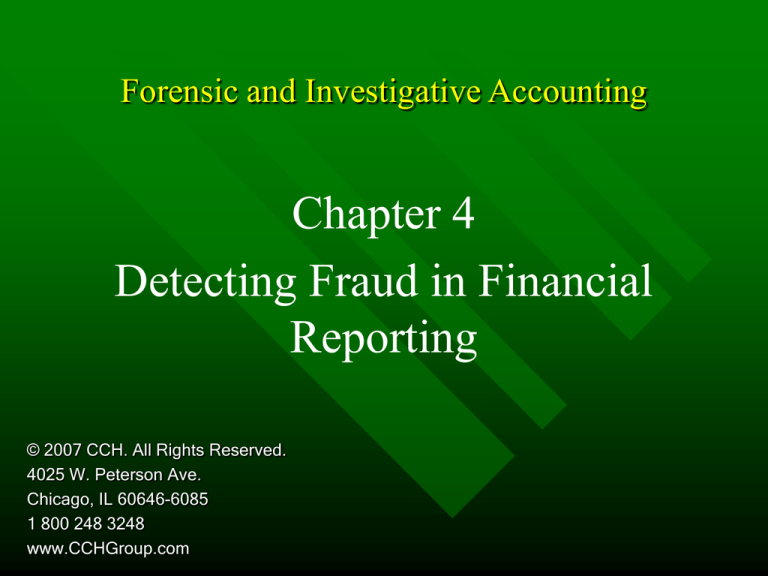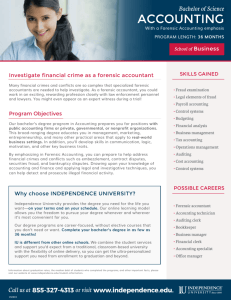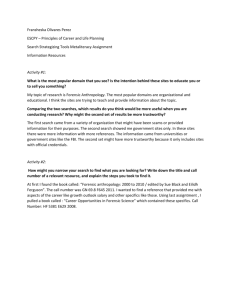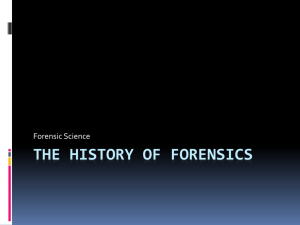
Forensic and Investigative Accounting
Chapter 4
Detecting Fraud in Financial
Reporting
© 2007 CCH. All Rights Reserved.
4025 W. Peterson Ave.
Chicago, IL 60646-6085
1 800 248 3248
www.CCHGroup.com
Definition of Fraud
Four major legal elements of fraud would be:
A false representation or willful omission
regarding a material fact.
The fraudster knew the representation was
false.
The target relied on this misappropriation.
The victim suffered damages or incurred a
loss.
Chapter 4
Forensic and Investigative Accounting
2
Audit Procedures
Audit evidence is gathered in two fieldwork
stages:
1. Internal control testing phase.
2. Account balance testing phase.
Chapter 4
Forensic and Investigative Accounting
3
Definitions
Materiality is the measure of whether
something is significant enough to change an
investor’s investment decision.
Control risk is risk that a material error in the
balance or transaction class will not be
prevented or detected.
Chapter 4
Forensic and Investigative Accounting
4
Definitions
Inherent risk is risk that an account or
transactions contain material misstatements
before the effects of the controls.
Detection risk is risk that audit procedures
will not turn up material error when it
exists.
Chapter 4
Forensic and Investigative Accounting
5
External Auditors and Fraud Detection
Although auditors have previously had the
responsibility to detect material misstatement
caused by fraud, SAS No. 82 details more
precisely what is required to fulfill those
responsibilities.
(continued on next slide)
Chapter 4
Forensic and Investigative Accounting
6
External Auditors and Fraud Detection
Now, auditors must specifically assess and
respond to the risk of material misstatement
due to fraud and must assess that risk from the
perspective of the broad categories in the
SAS. External auditors have to satisfy new
documentation and communication
requirements. SAS No. 82 superseded by SAS
No. 99.
Chapter 4
Forensic and Investigative Accounting
7
SAS No. 99 Recommendations
Increased emphasis on professional
skepticism.
Discussions with management.
Unpredictable audit tests.
Responding to management override of
controls.
Chapter 4
Forensic and Investigative Accounting
8
SAS No. 99: Skepticism
An auditor is instructed to conduct an audit
“with a questioning mind that recognizes
the possibility that a material misstatement
due to fraud could be present, regardless of
any past experience with the entity and
regardless of the auditor’s belief about
management’s honesty and integrity.”
FA’s motto should be “Trust no one;
question everything; verify.”
Chapter 4
Forensic and Investigative Accounting
9
Public Company Accounting
Oversight Board (PCAOB)
The Sarbanes-Oxley Act of 2002 created a new,
five-member oversight group called the
PCAOB.
The PCAOB is empowered to set accounting
standards that establish auditing, quality
control, and ethical standards for accountants.
(continued on next slide)
Chapter 4
Forensic and Investigative Accounting
10
Public Company Accounting
Oversight Board (PCAOB)
The PCAOB is also empowered to adopt or
amend standards issued or recommended by
private accounting industry groups or to
adopt its own standards independent of such
private industry standards or
recommendations.
Chapter 4
Forensic and Investigative Accounting
11
Walkthroughs
According to the PCAOB, in a walkthrough, an
auditor traces “company transactions and events
– both those that are routine and recurring and
those that are unusual – from origination,
through the company’s accounting and
information systems and financial report
preparation processes, to their being reported in
the company’s financial statements.”
Source: PCAOB Briefing Paper, Proposed Auditing Standards, October 7, 2003.
Chapter 4
Forensic and Investigative Accounting
12
Internal Auditors and Fraud Detection
The Institute of Internal Auditors’ Due
Professional Care Standard (Section 280)
assigns the internal auditor the task of assisting
in the control of fraud by examining and
evaluating the adequacy and effectiveness of the
internal control system.
(continued on next slide)
Chapter 4
Forensic and Investigative Accounting
13
Internal Auditors and Fraud Detection
However, Section 280 says that management
has the primary responsibility for the
deterrence of fraud, and management is
responsible for establishing and maintaining
the control systems.
In general, internal auditors are more
concerned with employee fraud than with
management and other external fraud.
Chapter 4
Forensic and Investigative Accounting
14
When Fraud Is Discovered
1.
2.
Notify management or the board when the
incidence of significant fraud has been
established to a reasonable certainty.
If the results of a fraud investigation indicate
that previously undiscovered fraud materially
adversely affected previous financial
statements, for one or more years, the internal
auditor should inform appropriate management
and the audit committee of the board of
directors of the discovery.
(continued on next slide)
Chapter 4
Forensic and Investigative Accounting
15
When Fraud Is Discovered
A written report should include all findings,
conclusions, recommendations, and
corrective actions taken.
A draft of the written report should be
submitted to legal counsel for review,
especially where the internal auditor chooses
to invoke client privilege.
3.
4.
Chapter 4
Forensic and Investigative Accounting
16
Audit Committee
The audit committee is the subcommittee of
an organization’s board of directors charged
with overseeing the organization’s financial
reporting and internal control processes. The
audit committee’s biggest responsibility is
monitoring the component parts of the audit
process.
Chapter 4
Forensic and Investigative Accounting
17
Management’s Role
The Sarbanes-Oxley Act of 2002 mandates
that CEOs and CFOs certify in periodic
reports containing financial statements filed
with the SEC the appropriateness of financial
statements and disclosures.
Chapter 4
Forensic and Investigative Accounting
18
Board of Directors’ Role
Oversee the integrity, quality, transparency,
and reliability of the financial reporting
process.
Oversee the adequacy and effectiveness of
the internal control structure in preventing,
detecting, and correcting material
misstatements in the financial statements.
Oversee the effectiveness, efficacy, and
objectivity of audit functions.
Chapter 4
Forensic and Investigative Accounting
19
Enter the Forensic Accountant
Forensic accountants may be brought in to:
– Investigate the minute any irregularities
surface.
– Measure risk factors and create policy that
brings the forensic accountant in when
certain scores are attained.
– Check in randomly as a matter of routine.
Chapter 4
Forensic and Investigative Accounting
20
Audit Tests
The Panel on Audit Effectiveness recommended
that surprise or unpredictable elements should be
incorporated into audit tests, including:
– Recounts of inventory and unannounced visits
to locations.
– Interviews of financial and nonfinancial client
personnel in different locations.
(continued on next slide)
Chapter 4
Forensic and Investigative Accounting
21
Audit Tests
– Requests for written confirmations from
client employees regarding matters about
which they have made representations to the
auditors.
– Tests of accounts not normally performed
annually.
– Tests of accounts traditionally or frequently
deemed “low risk.”
Chapter 4
Forensic and Investigative Accounting
22
Financial Statement Fraud
Categories and Red Flags
Overstated revenues.
Management estimates.
Pro formas can mislead.
Earnings problems: masking reduced cash flow.
Earnings before interest, tax, depreciation, and
amortization (EBITDA).
Excessive debt.
Inventory problems.
Chapter 4
Forensic and Investigative Accounting
23
Financial Statement Fraud
Categories and Red Flags
CPA problems.
Sales and expenses problems.
Big bath.
Balance sheet account problems.
Pension plan problems.
Reserve estimates (cookie jar accounting).
Personal piggy bank.
Barter deals.
Chapter 4
Forensic and Investigative Accounting
24
HealthSouth
From 1999 to 2001, HealthSouth’s net income
increased nearly 500 percent, but revenue grew
only five percent.
On March 19, 2003, the SEC said that
HealthSouth faked at least $1.4 billion in profit
since 1999.
Professional fees associated with the
reconstruction of HealthSouth’s financial records
and restatement of 2001 and 2002 consolidated
financial statements totaled over $270 million.
Chapter 4
Forensic and Investigative Accounting
25
Financial Fraud Detection Tools
Interviewing the executives.
Analytics.
Percentage analysis:
– Horizontal analysis.
– Vertical analysis.
– Ratio analysis.
Chapter 4
Forensic and Investigative Accounting
26
Financial Fraud Detection Tools
Using checklists to help detect fraud:
– SAS checklist.
– Attitudes/Rationalizations checklist.
– Audit test activities checklist.
– Miscellaneous fraud indicator checklist.
Chapter 4
Forensic and Investigative Accounting
27
Behavioral Approaches
Some fraud schemes cannot be effectively
detected using data-driven approaches.
Instead, behavioral considerations may help
an auditor find fraud. Employee attitudes,
feelings, values, norms, interaction with
peers, and general satisfaction should all be
considered when looking for fraud.
Chapter 4
Forensic and Investigative Accounting
28








